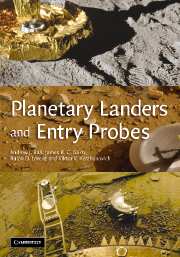Book contents
- Frontmatter
- Contents
- Preface
- Acknowledgements
- List of acronyms and abbreviations
- PART I Engineering issues specific to entry probes, landers or penetrators
- 1 Mission goals and system engineering
- 2 Accommodation, launch, cruise and arrival from orbit or interplanetary trajectory
- 3 Entering atmospheres
- 4 Descent through an atmosphere
- 5 Descent to an airless body
- 6 Planetary balloons, aircraft, submarines and cryobots
- 7 Arrival at a surface
- 8 Thermal control of landers and entry probes
- 9 Power systems
- 10 Communication and tracking of entry probes
- 11 Radiation environment
- 12 Surface activities: arms, drills, moles and mobility
- 13 Structures
- 14 Contamination of spacecraft and planets
- PART II Previous atmosphere/surface vehicles and their payloads
- PART III Case studies
- Appendix Some key parameters for bodies in the Solar System
- Bibliography
- References
- Index
2 - Accommodation, launch, cruise and arrival from orbit or interplanetary trajectory
Published online by Cambridge University Press: 12 August 2009
- Frontmatter
- Contents
- Preface
- Acknowledgements
- List of acronyms and abbreviations
- PART I Engineering issues specific to entry probes, landers or penetrators
- 1 Mission goals and system engineering
- 2 Accommodation, launch, cruise and arrival from orbit or interplanetary trajectory
- 3 Entering atmospheres
- 4 Descent through an atmosphere
- 5 Descent to an airless body
- 6 Planetary balloons, aircraft, submarines and cryobots
- 7 Arrival at a surface
- 8 Thermal control of landers and entry probes
- 9 Power systems
- 10 Communication and tracking of entry probes
- 11 Radiation environment
- 12 Surface activities: arms, drills, moles and mobility
- 13 Structures
- 14 Contamination of spacecraft and planets
- PART II Previous atmosphere/surface vehicles and their payloads
- PART III Case studies
- Appendix Some key parameters for bodies in the Solar System
- Bibliography
- References
- Index
Summary
The challenges involved in designing optimal trajectories for planetary landers or atmospheric probes are shared by many other types of spacecraft projects. Spacecraft, at least for the foreseeable future, have to be launched from the Earth's surface and then placed on a path that intersects the orbit of the target body. How this is achieved depends on the mission of the spacecraft and its associated cost and design details.
The launch environment
Spacecraft have been delivered to space on a wide variety of launchers, all of which subject their payloads to different acoustic, dynamic and thermal regimes. These parameters vary with the size and nature of the launcher, yet the complex launch vehicle industry often makes it difficult to isolate a preferred launcher type for a given mission. In Table 2.1 pertinent features of current launch vehicles are shown with data taken from their user manuals; the launcher market currently has over a dozen vehicles capable of lifting interplanetary payloads. Costs are not listed as many of the vehicles offer dual manifest capability, or other partial-occupancy accommodation (such as Ariane's ASAP) which can make heavy launchers and their capability available to even modestly funded missions.
Of particular interest are the mass values shown for the parameter C3. This quantity is the square of the hyperbolic escape speed; the speed an object would have upon leaving the influence of a gravitating body. Paths with a C3 greater than 0 km2 s−2 are trajectories which never return to their origin.
- Type
- Chapter
- Information
- Planetary Landers and Entry Probes , pp. 14 - 23Publisher: Cambridge University PressPrint publication year: 2007

